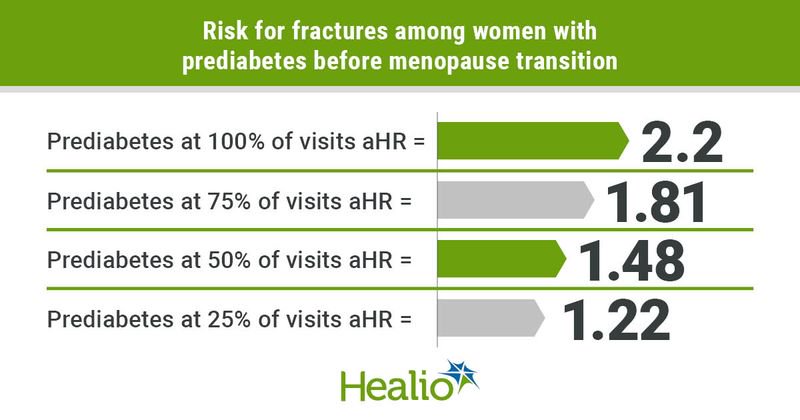Women with prediabetes before menopause may have increased risk for fractures
Key takeaways:
-
Women with prediabetes prior to menopause are more likely to sustain a fracture than women without prediabetes.
-
The risk for fractures is higher for women with prediabetes at more premenopausal visits.

Data were derived from Shieh A, et al. JAMA Network Open. 2023;doi:10.1001/jamanetworkopen.2023.14835.
Women who have prediabetes before transition to menopause have a higher risk for sustaining a fracture later in life than women without prediabetes, according to a study published in JAMA Network Open.
“Establishing whether prediabetes is a risk factor for fractures has potential public health implications,” Albert Shieh, MD, assistant clinical professor in the department of medicine at the David Geffen School of Medicine at University of California, Los Angeles, and colleagues wrote. “Nearly one in three U.S. adults has prediabetes, but clinicians debate the need to treat it, in part because prediabetes has not been directly linked to end-organ complications. Our results suggest that more consistently having a fasting blood glucose level in the prediabetes range before the menopause transition may be an independent risk factor for fracture.”
Researchers collected data from 1,690 women who participated in the Study of Women’s Health Across the Nation (SWAN) bone cohort beginning in 1996 (mean age, 49.7 years). Women who completed at least one visit before menopause transition, one visit after the start of menopause transition, were not taking a bone-beneficial medication before menopause transition and did not have type 2 diabetes were included in the analysis. Women were considered to have prediabetes before menopause transition if they had a FBG level between 100 mg/dL and 125 mg/dL and were not taking a diabetes medication at any visit. The occurrence of fractures after the start of menopause transition was reported through standardized questionnaires.
Of the cohort, 13.3% had prediabetes during at least one study visit prior to menopause transition, and 8% of the cohort sustained a fracture during menopause transition or after menopause. Incident fractures occurred in 11.1% of women with prediabetes and 7.6% of those without prediabetes. Mean time from the start of menopause transition to the time of fracture was 10 years.
After adjusting for covariates, women who had prediabetes during every visit before menopause transition had a higher risk for sustaining a fracture than women without prediabetes (adjusted HR = 2.2; 95% CI, 1.11-4.37). An increased risk for fractures was observed for women with prediabetes during 75% of visits (aHR = 1.81; 95% CI, 1.08-3.02), 50% of visits (aHR = 1.48; 95% CI, 1.05-2.09), and 25% of visits (aHR = 1.22; 95% CI, 1.03-1.45) before menopause transition compared with women without prediabetes. The associations were similar after further adjustments were made for lumbar spine and femoral neck bone mineral density.
In sensitivity analyses, women with prediabetes during any visit before menopause transition had a higher risk for fractures than women without prediabetes in models adjusting for lumbar spine BMD (aHR = 2; 95% CI, 1.27-3.15) and femoral neck BMD (aHR = 2.02; 95% CI, 1.28-3.19). Women with prediabetes during any visit prior to menopause transition had a higher risk for major nonvertebral fractures than women without prediabetes after adjusting for lumbar spine BMD (aHR = 2.65; 95% CI, 1-7.03) and femoral neck BMD (aHR = 2.71; 95% CI, 1.02-7.17).
“In this cohort study of midlife women, prediabetes before the menopause transition was associated with greater risk of subsequent fractures during the menopause transition and after menopause, independent of BMD,” the researchers wrote. “Because midlife fractures are associated with subsequent fractures in older age, future research could examine whether treating prediabetes before the menopause transition reduces the risk of different fracture outcomes later in life.”
